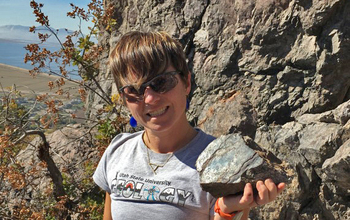Into the Faults They Go: Alexis Ault, NSF CAREER Awardee Cultivates STEM Identities for Utah Middle School Students
May 14, 2018
By Heidi Jensen
Alexandria, VA—After a day in a classroom learning about earthquakes, fifth- and sixth-graders in Utah eagerly trade in their books and binders for hiking boots and backpacks. They travel to the damage zone of the active Wasatch Fault in search of million-year-old clues about the Earth’s past. These young scientists read geological tea leaves of rock-slip processes, which lead to earthquakes and landslides.
They—like the cohort before them—collect prize rock samples and analyze them using scanning electron microscopy. Their goal is nothing short of discerning the thermochronology, or thermal history, of the 240-mile fault that averages at least one 6.5-magnitude or greater earthquake every 350 years.
"The primary byproduct of an earthquake is heat," says their fearless leader Alexis Ault, assistant professor of geology at Utah State University (USU), "which leaves behind a distinct texture and thermochronology signature on the fault rocks."
The high-powered scanning electron microscope at Utah State University allows students from Perry, Utah's Promontory School for Expeditionary Learning to snap pictures of a geological event’s signature written, literally, in stone.
Field and laboratory experiences allow students the opportunity to work alongside a team of interdisciplinary scientists from several universities and the U.S. Geological Survey. Students engage in real research. They identify and sample Wasatch mirrored faults, characterize the faults; and diagnose geohazards.
“The hands-on integration of research and education helps students form ‘STEM identities’ at a critical age,” says Ault. “This experience in a natural laboratory cultivates a real excitement about discovery and learning.”
In turn, the middle-school students’ excitement for science in their own backyards energizes the athletic Ault. She enjoys racing her mountain bike through the mountains and desert and will compete in a 550-mile race this summer.
A recipient of both a Post-Doctoral Fellowship in 2012 (NSF 11-44905) and Faculty Early Career Development 'CAREER' Award in 2017 from the National Science Foundation’s (NSF) Division of Earth Sciences, Ault continues to offer “uplifting” examples of broader impacts. She currently mentors two graduate students and a post-doctoral researcher, and pays it forward by also creating learning modules for other educators.
To date, Ault’s five-year, $631,000 CAREER award (NSF 16-54628) has taught four classes of middle schoolers and their parents about the fault and earthquake safety. The numbers will continue to grow as this athlete and advocate for STEM does not seem to do anything in moderation.
Ault was recently awarded the Charles and Nancy Naesar Prize by the International Standing Committee on Thermochronology for her groundbreaking research. The USU College of Science also named her Researcher of the Year.
If you would like timely news from the Division of Earth Sciences (EAR), subscribe to EAR Express Updates newsletter by sending a blank email to earth-subscribe-request@listserv.nsf.gov. You can unsubscribe at any time by emailing earth-unsubscribe-request@listserv.nsf.gov. Send updates and highlights about your NSF-funded research and education projects to EAR Communication!
The U.S. National Science Foundation propels the nation forward by advancing fundamental research in all fields of science and engineering. NSF supports research and people by providing facilities, instruments and funding to support their ingenuity and sustain the U.S. as a global leader in research and innovation. With a fiscal year 2023 budget of $9.5 billion, NSF funds reach all 50 states through grants to nearly 2,000 colleges, universities and institutions. Each year, NSF receives more than 40,000 competitive proposals and makes about 11,000 new awards. Those awards include support for cooperative research with industry, Arctic and Antarctic research and operations, and U.S. participation in international scientific efforts.
Connect with us online
NSF website: nsf.gov
NSF News: nsf.gov/news
For News Media: nsf.gov/news/newsroom
Statistics: nsf.gov/statistics/
Awards database: nsf.gov/awardsearch/
Follow us on social
Twitter: twitter.com/NSF
Facebook: facebook.com/US.NSF
Instagram: instagram.com/nsfgov



